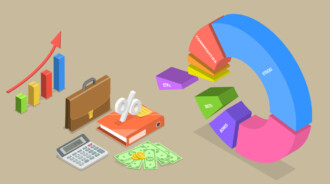

Money is what brings an investor or a trader to the market. But if the market is the same, then why two different terms? In this article, we shall clear all the doubts regarding these associated terms and much more which is essential for those interested in investing or trading in stock markets.
What is trading?
The exchange of goods and services between two entities is regarded as trading. In the literal sense, the entities are investors/traders who exchange stocks of different companies. Trading has been existing since the advent of the human race. Names have changed from barter systems to trading in exchange for gold or currency to cryptocurrency these days.
Trading goods and services created a larger community, and the markets have grown from village heart to cities, states, countries, and even across continents. It would not be wrong to say that today’s world is one unified single market.
The development of communication has played a crucial role in this, as we have now shifted from the physical stock markets to the digital ones. The geographical expansion of these markets started playing a significant role in the region’s economic development and thus became the mainstay of the financial world.
The restriction of access to trading in shares, commodities, currency, etc., to a limited section of people, has significantly been removed due to the advent of online trading platforms. Today, one can trade from the comfort of their home or even while traveling through mobile apps and websites.
Trading versus investing is a short-term process that involves buying and selling stocks, commodities, currencies, derivatives, or other financial instruments. The primary objective in trading is to make profits from the short-term movement in prices of these assets.
Today’s digital stock markets have provided traders with the latest chart-based trading techniques to detect short-term price patterns. These patterns help them determine the support and resistance levels and the appropriate trade entry points and choose the right strategies. This technical analysis has grown over the last century, and today, multiple layers and databases enable traders to make correct and quick decisions.
Types of trading in the stock market
Modern trading revolves around five types. Let’s meet each of them.
Day trading
This is a fast-paced trading system in which stocks are held from a few minutes to hours during one trading day. Traders involved in such trade must close their transactions before the day’s market closure. It is famous for capitalizing on small-scale fluctuations in stocks.
Scalping
Scalping, also known as micro-trading, is a subset of intraday trading. It involves reaping small profits repeatedly, from a dozen to a hundred in one market day. However, every trade doesn’t yield a profit; sometimes, a trader’s loss might exceed the income. The holding period of assets is generally restricted to a few minutes only.
Swing trading
It is used to capitalize on short-term stock trends and patterns. Swing trading is done to gain profits from stocks within a few days of buying them, ideally one to seven days. Traders technically analyze the stocks to gauge the price movement patterns and get profits.
Momentum trading
In this kind of trading, a trader tries to exploit the momentum of a stock price, which can be upward or downward. A trader attempts to profit on such momentum by identifying the stocks that either break out or will break out shortly.
In upward momentum, the trader sells the stocks to make a higher-than-average profit. In downward movement, the trader purchases a considerable volume of stocks to sell when their price increases.
Position trading
Traders hold assets for several months, intending to profit from the stock’s long-term potential rather than short-term price movements. This trading style is ideal for individuals who do not wish to remain constantly in touch with the stock market.
Note! Although trading offers good liquidity and profits, it also contains high risks of losing funds.
What is investing?
Investors aim to profit from the gradual growth of the market. They increase their profits over a long period by buying and holding a portfolio of stocks, mutual funds, bonds, and other financial instruments.
This asset holding is often done over years, or even decades, taking advantage of incentives like interest, dividends, and stock splits. The market remains volatile, but investors are patient, especially during a downtrend.
They move cautiously but take risks while waiting for the market reversal and eventually intend to make profits when a boom occurs. Investors usually take note of market fundamentals, such as price-to-earnings (P/E) ratios and management predictions.
Investing is done by buying assets such as stocks or other financial instruments likely to generate returns over a long period. The aim is to identify potential investment targets. The expectation is to create a portfolio with varied stocks and instruments likely to grow. Variety ensures that the loss from one stock is compensated by the other.
Frequent selling is prohibited while dealing in investments. Only in emergency cases is it recommended to sell shares. But this doesn’t mean that investors do not act against a likely long-term fluctuation in a particular stock, the decline in the company’s profile, etc. The aim ultimately is still to make a profit.

Trading vs. Investing: The key differences
The intention of the traders and the investors is the same — to get a profit. However, there are several differences between trading and investing, but the key differences are the investment approach and the time involved.
| Parameter | Investing | Trading |
| Aim | To profit by buying and holding shares for a long period | To profit from the differences in stock prices in the short term |
| Risk involved | Lower risk as selling can be held until the price improves. | High risk as less time is available for market analysis |
| Time | It can be for a few months to a few years or maybe even decades | It is carried out over a shorter period: from a few seconds to several days or months |
| Profit | Higher profits as more time is given to the growth of the stock | Fast trading, but less profit than investors. |
| Any additional income | Dividends, interests, and share splits become a part of the earnings | No, a profit is generated only by the increase in the asset price |
| Efforts | More time and effort are involved in the initial company planning and analysis | Continuous market research |
| Is any leverage provided? | No leverage | Leverage is available |
Trading vs. Investing: Which is better?
In comparison, investing can seem better to some people than trading because it is more accessible in terms of the time and effort involved. But is it so? Investments warrant a one-time effort in carefully selecting the stock, but trading is a continuous job of reading and analyzing the market.
Investing is a long-term project, and the risks involved are comparatively lesser. Conversely, a trader must have enhanced market skills in real-time analysis and identifying quick-time price movements.
If you can wait, investing is better for you. But trading is the most suitable if you are interested in short-term profits and have an appetite for taking risks.
Individual capabilities in fund management, risk-taking abilities, time for market analysis, knowledge, and expertise will dictate the choice between trading and investing. Both have the potential to earn profits. Thus, it is difficult to say which is better. It all depends on your attitude to the market.
Who should invest, and who should trade?
Understanding the differences allows an individual to choose whether to become a trader or an investor. Trading suits you if you have the time and skill to analyze the market and understand the stock activities.
If you have time, you can choose to invest. You must analyze financial statements, company growth, history, financial predictions, etc. This should be considered as something other than a one-time job. It is still essential to keep an eye on the company’s activities. Timelines are longer, and vigorous scoping is not required. Dividends and stock splits keep you in the loop. If you regularly receive dividends, it is safe to assume that the company is doing well.
In summary, both traders and investors rely on different skills. Investors should focus on fundamental analysis, and traders should rely on technical analysis.
What is the investor vs. trader mindset?
Traders are fast-paced and have quick analytical minds. They rely on instinct and have a greater risk appetite. On the other hand, investors need time to analyze a particular company and stock performance critically. They are willing to wait for a profit for a long time.
The approach of an investor is cautious as compared to a trader. Thus, investors are more likely to prefer a passive approach, whereas traders are likely to choose an active method to the market.
FAQs
What are the types of trading?
There are primarily four types of trading. They are swing, position, day, and scalp trading.
Which is riskier, trading or investing?
Trading is fast-paced and involves more risk since it is based on the high-risk-reward approach. Investing is a long-term strategy and thus has lesser risk.
What are the types of investing?
Investing is classified under active, passive, value, growth, index, and market cap-based investing.
Between trader and investor, who earns more profits?
Traders and investors operate in the market to get profit. Traders, however, earn instant profits if they make the right decision and time. Investors earn in the long term and also get additional earnings through dividends.
The bottom line
By now, you must have understood the difference between trading and investing. Both of them are done to earn profits. Traders and investors have different approaches while handling and managing the market. Investors rely on long-term earnings, and traders, on the other hand, want to make quick profits. One can even choose to do both. The choice primarily depends upon an individual’s risk-taking ability and patience level.
Investing involves lesser risk, while trading is short-term and involves high risk. Both have the potential to earn profits, but traders are likely to make quick profits if their decision-making ability is reasonable and based on correct market analysis.










